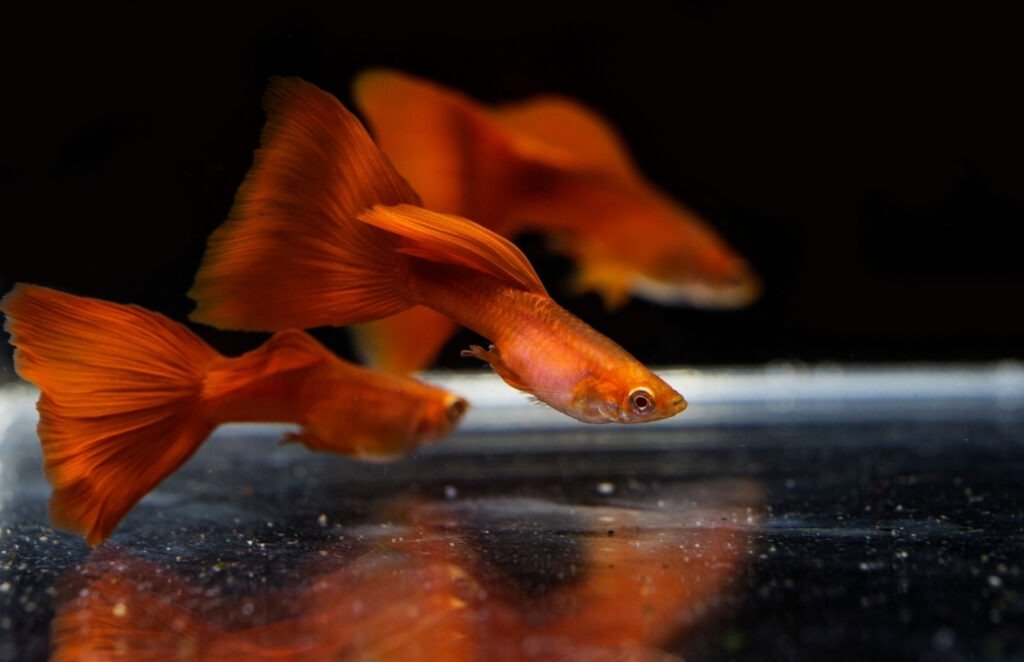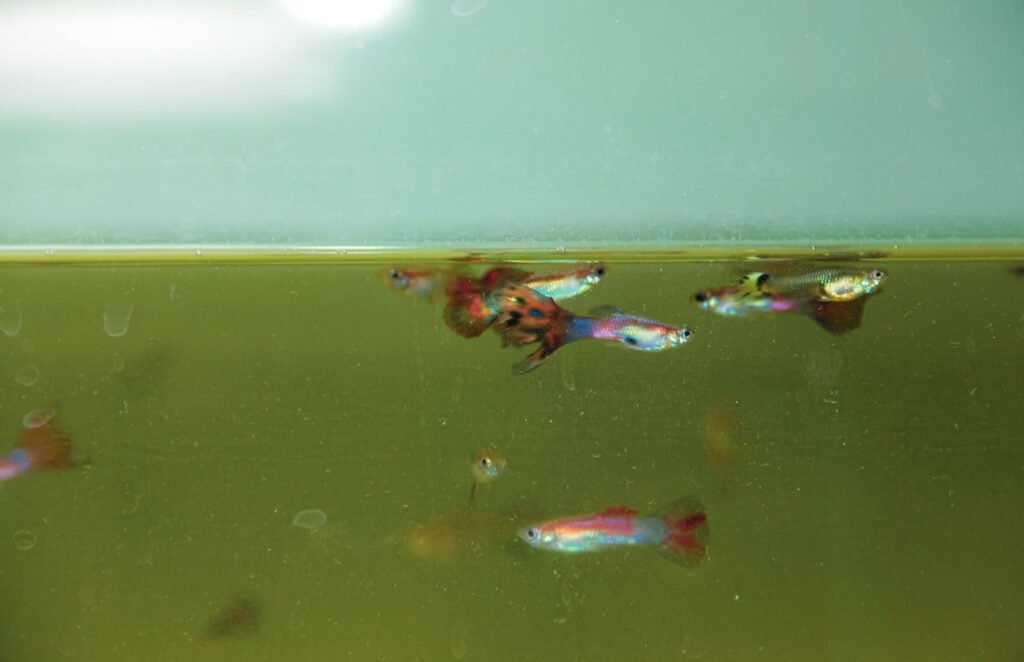
Feeding Tips for Healthy Guppies
Why do people prefer guppies for their home aquariums? The reasons may differ for different people. Low maintenance, vibrant nature, and beautiful color make guppies a more attractive choice for many of us. Be careful about their diet and give them a balanced diet if you want to make them healthy and colorful. Let’s disclose the world of Feeding Tips for Healthy Guppies! The next section of the blog post will discuss some food varieties, such as natural, commercial flake, and pellet foods, as live and frozen foods. Additionally, we will discuss feeding tips. So stay with us if you want to give your guppies the best diet to ensure their health, happiness, and appearance.
Natural Diet of Guppies in the Wild
To fulfill their nutritional needs, you must have a sound understanding of eating behaviors of guppies in their natural habitat.
Natural Habitat: South American countries such as Guyana, Venezuela, and Brazil have freshwater rivers and streams and guppies prefer to live there and so they are natural habitat for them. The best thing about these habitats is that they provide a variety of foods and it helps them to thrive in these environments.
Diet From the Wild: Plants and animals are the primary source of their food for guppies in their natural environment. Their diet includes:
- Insects and Larvae: Do you know why guppies prefer tiny insects and larvae? Because they are rich sources of protein and for growth and reproduction they need such proteins.
- Algae: Guppies consume algae as a food that grows on rocks and plants, and for guppy’s diet, algae are considered a vital food item because they nourish fry and give them a vibrant color.
- Plant Matter: Small plant debris and other organic matter particles make up a guppy’s diet.
Inside Considerations: As we discussed, understanding of guppies’ diet plays an important role in their health and vibrancy. Boosting a guppy’s immune system, coloration, and improving health is possible only with a balanced diet that mimics natural feeding habits. After understanding your guppies’ nutritional requirements, it will be helpful to thrive in captivity.
Commercial Guppy Food Options
Using commercial flake food is the easiest and most reliable way to feed your guppies. Below are some common types:
Flake food:
Staple Diet: Flake food is popular with guppy owners due to its convenience and availability. This food item provides a balanced diet of essential minerals, protein, and healthy cholesterol to nourish tropical fish like guppies. These nutrients boost fish health and color.
- Pros: Flake foods are beneficial for fish feeding. First, they are easy to store, so fish keepers can easily stock up. Flake foods are easy to portion, so fish get enough food. Finally, flake food is easy to feed, so many fish keepers prefer it. These formulations contain vitamins and minerals that can improve fish health and color.
- Cons: The drawback of flake food is that it is available in different qualities, which may be low-standard and harmful. Please avoid those low-cost brands with many fillers and little nutritional value. The nutrient content of flakes can quickly decrease when exposed to air, so be careful and keep your fish balanced diet.
Pellets:
- Nutrient Value: Pellets are a more concentrated form of food offering rich nutrients. Depending on your guppy’s feeding habits, choose from floating or sinking varieties.
- Choosing the Best Pellets: You should buy pellets made for small tropical fish. High-quality pellets should contain fish meal, prawns, or similar ingredients; thus, they will be high in protein.
- Feeding Tips: Pellets may be too big for fry or juveniles, so only feed them to adult guppies. Before feeding, soak pellets briefly in water to improve digestibility.
Freeze-Dried and Frozen Foods:
Common Choices: Bloodworms, daphnia, and brine shrimp should be freeze-dried and frozen for guppies. These foods are high in protein. These options provide all the essential nutrients and encourage their natural searching behaviors, mimicking their natural diet. This may make the fish’s aquarium more lively and stimulating.
Benefits: As discussed in the previous section, frozen and dried foods contain protein and essential nutrients. So, they make them a great addition to your guppies’ diets. Moreover, you can store dried foods easily for a long period, and this makes them a convenient choice. It could be a great choice for nutritionists because they are rich in nutrients.
Feeding Tips: You cannot use these foods daily because they are occasional treats and you must be aware of them. Calculate the amount of freeze-dried foods before giving to your guppies. It will save your guppies from bloating and digestive problems. Give them a variety of foods but at a moderate level.

Live Foods for Guppies
Live foods offer a great way to improve your guppies’ diet by mimicking their natural environment.
Types of Live Foods:
- Brine Shrimp: Especially for fry, brine-soaked prawns are great for guppies. Due to their high protein and nutrient content, these products promote rapid growth and color vibrancy. Brine prawns are convenient and nutritious. They can be bought at pet stores or raised at home, making them a simple choice.
- Daphnia: Small crustaceans such as Daphnia offer a wide range of protein and fiber. And guppies need such foods for better nourishment and to improve digestive issues. Guppies eat them without hesitation.
- Mosquito Larvae: Mosquito larvae are a great wild food source. Their high protein content makes them a good choice for growing young guppies. They emphasize fostering your guppies’ natural hunting instincts, which improves their environment.
Benefits of Live Foods:
- Nutritive Value: Guppies get essential nutrients from live foods that are vital for their health, energy and colors. Not only will this process encourage natural hunting and foraging instincts but also make aquariums more engaging. So, it will reduce stress and boredom and they will get a stimulating and interactive environment as a result.
- Health Benefits: For boosting of immune system, growth and reproduction you need to consistently feed live foods to your guppies. Doing so will be helpful for the health of fish to thrive in captivity.
Risks and Considerations:
- Disease Transmission: Giving your aquarium live foods raises the risk of introducing diseases or parasites. Live foods from reliable suppliers must be quarantined before feeding them to your guppies. This reduces guppies’ risk.
- Cost and Maintenance: While live foods have many benefits, they may require more money and effort to obtain or grow than commercial food alternatives. However, their nutritional and behavioral benefits often make them a worthwhile investment.
Vegetable-Based Foods for Guppies
Guppy’s health depends on plant matter in their diet. They need plant matter for nutrients and fiber.
Significance of Plant Matter:
For better growth and energy, guppies require a balanced diet and plants are useful because they contain protein and nutrients. Vegetables and algae are the sources of vitamins and minerals and guppies need them for their health, digestion, and vitality.
Common Vegetables and Their Preparation:
- Blanched Spinach: Spinach contains high vitamins and minerals, so you call it a healthy choice for guppies. For desirable results, it is necessary to boil spinach and then cool down in cold water. This process will make leaves more soft and now guppies can eat them easily.
- Peas: Your guppies should eat peas because they contain a lot of fiber, which prevents constipation. The peas should be chopped into small, manageable pieces and the skin removed before feeding. This guarantees top-quality peas.
- Zucchini: Guppies love zucchini, making it a great food for them. Thinly slice and blanche the courgette for tenderness. Guppies will love the soft interior of this food because it is easy to digest and full of nutrients.
Algae:
- Natural Diet Component: Guppies eat algae, which is abundant in their natural environment. Guppies eat algae naturally. Encourage controlled algae growth in your tank to give your fish a natural and consistent food source that is similar to their diet.
- Algae Wafers: If your tank lacks algae, algae wafers are a convenient alternative. These wafers are great for giving your guppies algae. They can also benefit herbivorous tank mates.
Feeding Schedule and Tips
Feeding guppies requires more than choosing the right foods. You must monitor their feeding frequency, portion control, and diet to ensure a balanced diet.
Feed Guppies Regularly:
- Feeding Frequency: Due to their rapid growth, fry may need three or four feedings a day, but adult guppies do well with once or twice a day. For their development, they need consistent nutrition and close supervision. Remove uneaten food immediately to maintain water quality and prevent decomposition.
- Signs of Overfeeding: Cloudy water, excessive waste, obesity, and digestive issues are the common signs of overfeeding in guppies. Sluggish behavior or bloated bellies may indicate overfeeding your pet.
Portion Control
- Calculating Feed: Give your guppies enough food that they can eat in two to three minutes. If any food is left over, adjust the portion size at the next feeding to avoid waste and water contamination.
Diet Varieties:
- Varied Diet: If you have various food options, you can keep your guppies healthy and engaged. A balanced diet may be varied because it includes flake food, pellets, live or freeze-dried foods, and vegetables that fulfill a guppy’s requirements. Following this approach will provide necessary nutrients and also make mealtime exciting, which may increase hunger.
Feeding Fry
- Special Considerations: Fry have smaller mouths and faster metabolisms, so they need less food but frequently. Remember this crucial point. Crushed flakes, baby brine shrimp, and microworms are ideal for these tiny fish. After a certain time, you can gradually introduce your fry to an adult diet but you need to adjust portion sizes and food varieties.
Common Mistakes to Avoid
You must be careful and avoid common mistakes while feeding your guppies.
Avoid Overfeeding:
- Overfeeding Threats: You must calculate the quantity of food before feeding in order to avoid overfeeding. It’s because if you overfeed and if it remains uneaten, chances are there they start decomposing in the water tank and harm the quality of water. As a result, fish survival can decline with ammonia levels. Also, overfeeding may cause obesity and other health concerns.
Neglecting Variety:
- The Importance of a Varied Diet: Relying on one type of food leads to certain nutritional deficiencies, so making a planned diet will ensure that you feed all the nutrients, minerals, and other essential meals. Like other animals, guppies flourish on varied diets.
- Disregarding Special Dietary Needs: Possible Sick or Pregnant Guppies
Conclusion:
In summary of feeding tips for healthy guppies require a balanced diet to get essential nutrients to look vibrant and healthy. Offering a variety of foods and their understanding of utilizing them in special time zones and controlling portions make them a balanced diet. This his will allow a balanced diet to mimic guppy’s feeding habits. Although they do not require much maintenance, you must understand small steps and avoid common mistakes that make them healthy and colorful.